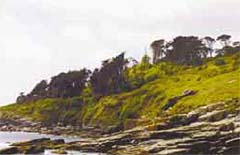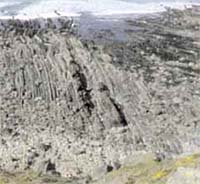|
|
||
|
As a member of the Trust, you will be aware that all of our nature reserves are open to the public. However, did you know that there are approximately 40 miles of paths and tracks across the Trust's 46 sites? These routes are all maintained to ensure that access is both enjoyable and safe. The Heritage Lottery Fund grant- aided Wild Cornwall project has enabled us to enhance many of the routes by installing waymarking arrows, information boards, boardwalks and bridges. So, why not take advantage of the improved access routes and get out and about to explore some of our nature reserves? Brief details are provided here for sites throughout Cornwall but refer to the Trust's reserves leaflet - available from HQ - for information on the rest. West Cornwall - Kemyel Crease Kemyel Crease is located between Lamorna and Mousehole
on the South West Coast Path. The reserve provides an interesting contrast
to the majority of this section of coastline as it supports conifer
woodland which was planted to provide shelter for the market gardening
business which existed there in the early part of this century. The
south- facing cliff slopes were terraced and divided by stone walls
into small fields known as quillets. Initially bulbs were grown in the
fields but later, during World War II, potatoes were cultivated. Today,
Kemyel Crease is an important haven, rich in wildlife. Birds nest and roost in the trees, and as the trees die and fall, the dead wood created becomes an important habitat for insects. Kemyel Crease has a new information board and seat, thanks to the generosity of Heike Neunaber and Rudiger Wohlers who donated their wedding gift funds towards the reserve's management. Other reserves to visit in west Cornwall include Chūn Downs and Bosvenning Common, which are both important heathland sites. Loggan's Moor and Caer Brān are also interesting sites, in addition to St Erth Pits which is the Trust's first geological site. The Trust is also currently negotiating a long lease for Upton Towans, which is a large area of sand- dunes on the north coast near to Hayle. Mid- Cornwall - Cabilla and Redrice Woods When the Trust first purchased this site there was relatively little public access to it despite its two public footpaths. One of these paths leads through the woods and out onto Tawna Downs to the north; this presents very few problems. However, the other path passes through Cabilla and Redrice Woods until it reaches the site boundary where it abruptly stops! Anyone following it could have been forgiven for thinking that it led somewhere (as most footpaths do), taken a wrong turn and become lost very easily. To overcome this potential problem, a number of existing but overgrown tracks have been opened up and new footpaths created. Bridges, boardwalks and waymarking arrows have been installed to complete the nature trail. Nature trail leaflets are available at the entrance to the reserve or from Five Acres. Other reserves to visit in mid- Cornwall include Breney Common and Red Moor via the Wilderness Trail. East Cornwall - Penlee Battery Penlee Battery is in the far south- east of Cornwall on the Rame Peninsula. Now a nature reserve rich in wildlife, this site is one of a series of defensive batteries built in the late 19th century to protect Plymouth. It supports mixed woodland, scrub and open grassland habitats. The open grassy areas and wide tracks make the reserve easily accessible to wheelchair users, and the Trust has installed a wide boardwalk section to improve access further. When the sun shines, wild camomile scents many areas along the tracks at Penlee, and the bee orchids flowering in June are a beautiful sight to see. Other reserves to visit in east Cornwall include Sylvia's Meadow, which supports eight different species of orchid, Tincombe, which is an interesting urban reserve in Saltash, the Tamar Estuary, Redlake Cottage Meadows and Loveny/ Colliford Reservoir. |
||
 Bee orchid. Our many paths and tracks will bring you into contact with the most beautiful and unusual of species. Photo: Steve Adams |
Photo: Stuart Hutchings |
|
|
North Cornwall - Phillips's Point Phillips's Point is a small area of cliff- top land two miles south of Bude. The reserve supports communities of salt- tolerant plants and shrubs which are bent over and pruned by the constant wind. The cushion- forming plants occurring at Phillips's Point are interesting to observe but it is very likely that your gaze will be drawn out to sea. You may be lucky enough to observe the groups of bottlenose dolphins which are sometimes spotted along this coast. Other reserves to visit in north Cornwall include Maer Lake for birdwatching, Welcombe and Marsland (call the Trust before visiting) and Creddacott Meadows. Victoria Scott |
||


